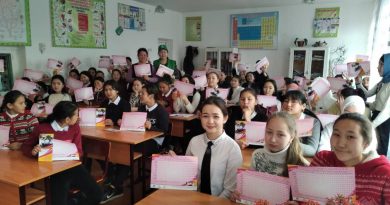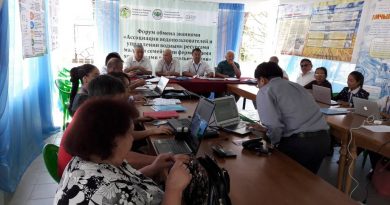Trainings under the project that help to increase agricrop yields of farmers-water users
Since the beginning of 2019 during the implementation of Component -2 activities: under the “Agricultural Productivity and Nutrition Improvement Project” Agricultural advisory services were held in Osh, Jalalabad and Batken oblasts, a series of trainings for members of the target WUAs Taimonku, Obi-Khaot, Kirk-Bulak, Kur-Tash, Gauyan, Ak-Zhol-Suu and Sulayman-Suu were conducted, the number of WUA members participated -725, including 107 women.
The main purpose of the trainings was to increase the capacity of the WUA administration in preparing and conducting tenders independently in accordance with the procedures presented in the WUA Procurement Manual for the implementation of small grants, as well as to increase the knowledge of WUA member farmers in the field of agricultural technologies for growing agricrops.
The objectives of these trainings were to study procurement methods, prepare the necessary tender documents, technical specifications, learning skills in preparing technical specifications and tenders for the procurement of goods and works, as well as learning of new pest control methods, and raising the corn and cotton plant properly.
Consultations on the elaboration of WUA agricultural development plans and a micro-project, as well as training on procurement procedures, preparation of technical specifications, contract conclusion and management of Revolving Seed and Fertilizer Fund were held for WUA management, representatives of the WUA Council and local authorities, including members of working groups on micro-project implementation.
A series of trainings on agritechnology were held for WUA farmer members. In the opinion of WUA member farmers, particularly useful training was on-site theoretical and practical consultations on agrotechnology for growing corn and cotton plant.
The practical consultations during the field trips were highly appreciated by the farmers, since some farmers do not always carry out agricultural practices correctly, for example, they irrigate corn at high irrigation rates, using long furrows during irrigation, do not monitor harmful insects, poor-quality plowing, resulting in uneven growth and poor development of corn. As a result, farmers were presented with relevant recommendations on the right agricultural practices, irrigation methods and methods for controlling corn pests.
Practical training conducted on the corn field of one farmer. The corn condition in the milk stage was observed. The corn condition is above average. The yields are expected above average, so irrigation is highly needed. Partial harmfulness of the 2nd generation corn borer was observed. Partial corn aphid was observed, which negatively affects the corn yield. It should be emphasized that corn aphid is the result of improper agricultural practices for growing corn at the very beginning of the vegetation season.
After monitoring the corn fields, farmers were shown the practical application of trichogramma and habrobracon against the corn borer and the following suggestions and recommendations were given:
- To carry out foliar application with biohumus, 3-4 liters per hectare (normal) in operating fluids 100 -150 liters of water.
- Irrigation services on regular basis.
- Use habrobracons at a rate of 300 pieces per hectare.
- Taking into account the given recommendations and suggestions, make the optimal planning of agricultural technology for growing corn for next year and selection of high-quality seeds.
Consultations on the agrotechnology of growing cotton plant were carried out individually with a visit to the field of each farmer in order to provide recommendations based on the condition of the plants and field. This consultation method has been selected to improve the efficiency of growing cotton plant. The concept of this practical teaching procedure is to provide consulting services and recommendations to farmers on the basis of studying the condition of their fields and plants, discussion of problems and matters. In the summer season (July), the risk of damage from cotton pests is very high, therefore the inspection of the fields was carried out with the aim of preventing plants, learning the method of pest control of cotton plant. The farmers were provided with individual consultations and in small groups of 3-4 farmers.
In addition to abovementioned trainings, a series of trainings planned for farmers in vegetable farming and horticulture, including an economic analysis of growing agricrops.




